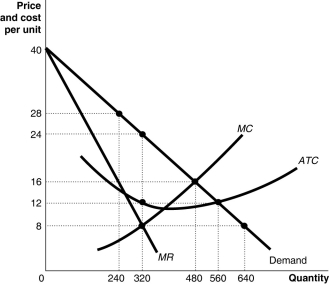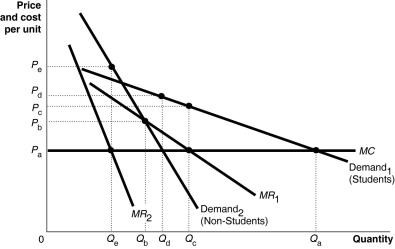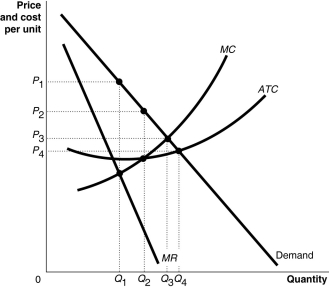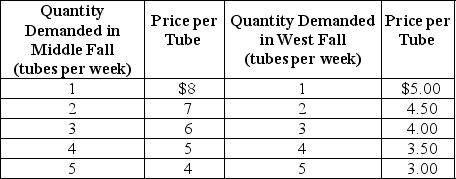A) the law of one price does not hold.
B) the firm earns arbitrage profits.
C) consumers whose demand for the product sold is more elastic pay higher prices than consumers whose demand is less elastic.
D) the marginal cost of production is constant.
Correct Answer

verified
Correct Answer
verified
Multiple Choice
With perfect price discrimination,the marginal revenue curve
A) is below the demand curve.
B) is above the demand curve.
C) is equal to the demand curve.
D) is horizontal.
Correct Answer

verified
Correct Answer
verified
Multiple Choice
Figure 16-5  -Refer to Figure 16-5.Suppose the firm represented in the diagram decides to use a two-part pricing strategy such that it charges a fixed fee and a per-unit price equal to the competitive price.(This is also called an optimal two-part tariff.) What is the per-unit price it should charge,if any?
-Refer to Figure 16-5.Suppose the firm represented in the diagram decides to use a two-part pricing strategy such that it charges a fixed fee and a per-unit price equal to the competitive price.(This is also called an optimal two-part tariff.) What is the per-unit price it should charge,if any?
A) It should not charge a price per unit; just a flat fee to consume as much of the product as desired.
B) It should charge a range of prices from $40 to $12.
C) $12
D) $16
Correct Answer

verified
Correct Answer
verified
True/False
One reason why McDonald's charges a single price for its products is that it is difficult and costly for the company to determine each individual consumer's willingness to pay.
Correct Answer

verified
Correct Answer
verified
Multiple Choice
Figure 16-2  Plato Playhouse, a theatre company in the university town of Wegg, caters to two groups of customers: students and the non-student population. Figure 16-2 shows the demand curves for the two groups of customers.
-Refer to Figure 16-2.What is the price charged in the two markets?
Plato Playhouse, a theatre company in the university town of Wegg, caters to two groups of customers: students and the non-student population. Figure 16-2 shows the demand curves for the two groups of customers.
-Refer to Figure 16-2.What is the price charged in the two markets?
A) price in the student market = price in the non-student market = Pa
B) price in the student market = price in the non-student market = Pb
C) price in the student market = Pd; price in the non-student market = Pe
D) price in the student market = Pc; price in the non-student market = Pe
Correct Answer

verified
Correct Answer
verified
Multiple Choice
Which of the following firms is most likely to use cost-plus pricing?
A) A firm that makes one product.
B) A firm that sells one product and has a sizable research and development budget.
C) A firm that makes several products and has a sizable research and development budget, the cost of which cannot be easily assigned to each product.
D) A firm that makes many products but has a small research and development budget, the cost of which can be easily assigned to the different product lines.
Correct Answer

verified
Correct Answer
verified
Multiple Choice
When you buy at a low price in one market then sell at a higher price in another market you are engaging in
A) odd pricing.
B) arbitrage.
C) an antitrust prohibited practice.
D) price discrimination.
Correct Answer

verified
Correct Answer
verified
Multiple Choice
Cost-plus pricing may be a reasonable way to determine price when
A) marginal cost and average fixed cost are roughly equal.
B) marginal cost and average cost are about the same.
C) marginal cost differs significantly from average cost.
D) marginal cost is very low.
Correct Answer

verified
Correct Answer
verified
Multiple Choice
The Walt Disney Company is in a position to use a two-part tariff by charging for admission and also charging for rides inside its two theme parks,Disneyland and Disney World.Which of the following statements regarding Disney's pricing strategy is true?
A) At one time, admission fees were charged at both parks but all rides were free. Disney has since changed its pricing policy; it earns higher profits by charging for both admission and rides.
B) At one time, customers had to pay for admission and rides at Disneyland and Disney World. Disney has since changed its pricing policy; it earns higher profits by charging for admission but not for rides.
C) At one time, customers had to pay for admission and rides at Disneyland and Disney World. Disney has since changed its pricing policy; it earns higher profits by charging for rides but not for admission.
D) At one time, fees for admission and rides at both parks were set at their profit-maximizing levels. Disney has since changed its pricing policy; it uses a cost-plus pricing strategy for admission and does not charge for rides.
Correct Answer

verified
Correct Answer
verified
Multiple Choice
Cost-price pricing typically does not result in profit-maximization.As a result,economists have two views of cost-plus pricing.One of these views is
A) cost-plus pricing is more likely to lead to profit-maximization for large firms than for small firms.
B) cost-plus pricing is a good way to approximate the profit-maximizing price when marginal revenue or marginal cost is difficult to determine.
C) cost-plus pricing is more likely to lead to profit-maximization for monopolistically competitive firms than for oligopoly firms.
D) cost-plus pricing is more likely to result in profit-maximization the more elastic the firm's demand curve is.
Correct Answer

verified
Correct Answer
verified
Multiple Choice
Transactions costs refer to
A) the implicit costs of production.
B) the costs in time and other resources that parties incur in the process of agreeing to and carrying out an exchange of goods or services.
C) the raw material cost of production.
D) the cost of transporting goods from one destination to another.
Correct Answer

verified
Correct Answer
verified
True/False
Perfect price discrimination will lead a firm to produce up to the point where price equals marginal cost,the efficient level of output.
Correct Answer

verified
Correct Answer
verified
Multiple Choice
Figure 16-1  -Refer to Figure 16-1.What is the economically efficient output level?
-Refer to Figure 16-1.What is the economically efficient output level?
A) Q1 units
B) Q2 units
C) Q3 units
D) Q4 units
Correct Answer

verified
Correct Answer
verified
Multiple Choice
Price discrimination is a rational strategy for a profit-maximizing firm when
A) it is possible to engage in arbitrage across market segments.
B) it is not possible to segment consumers into identifiable markets.
C) there is no opportunity for arbitrage across market segments.
D) firms want to increase the amount of consumer surplus received by its customers.
Correct Answer

verified
Correct Answer
verified
Multiple Choice
Table 16-2
 Neem Products sells its Ayurvedic Neem toothpaste in two completely isolated markets with demand schedules as shown in Table 16-2. The average cost of production is constant at $2 per tube.
-Refer to Table 16-2.What is the total revenue received from both markets combined?
Neem Products sells its Ayurvedic Neem toothpaste in two completely isolated markets with demand schedules as shown in Table 16-2. The average cost of production is constant at $2 per tube.
-Refer to Table 16-2.What is the total revenue received from both markets combined?
A) $30
B) $34
C) $68
D) $70
Correct Answer

verified
Correct Answer
verified
Multiple Choice
Though large firms have the knowledge and resources to utilize a better pricing strategy,many choose to use cost-plus pricing.One reason for this is that
A) large firms do not have to maximize their profits because they face little competition from other firms.
B) there is less risk of violating antitrust laws if a cost-plus pricing strategy is used rather than a profit-maximizing pricing strategy.
C) the additional revenue that would result from a profit-maximizing pricing strategy is an insignificant fraction of the firms' revenues.
D) firms often adjust the markup they charge to reflect current demand.
Correct Answer

verified
Correct Answer
verified
Multiple Choice
Many colleges and universities practice yield management to maximize the revenue they receive from tuition and
A) to maximize the amount of aid they receive from the federal government.
B) to maximize the amount of their student loans.
C) to maximize the size of their endowments.
D) to increase the academic quality of the students who enroll in their schools.
Correct Answer

verified
Correct Answer
verified
Multiple Choice
Figure 16-5  -Refer to Figure 16-5.Suppose the firm represented in the diagram decides to act as a monopolist and charge a single price.What is the profit maximizing quantity produced and what is the price charged?
-Refer to Figure 16-5.Suppose the firm represented in the diagram decides to act as a monopolist and charge a single price.What is the profit maximizing quantity produced and what is the price charged?
A) Q = 240 units; P = $28
B) Q = 320 units; P = $24
C) Q = 480 units; P = $16
D) Q = 560 units; P = $12
Correct Answer

verified
Correct Answer
verified
Multiple Choice
Table 16-2
 Neem Products sells its Ayurvedic Neem toothpaste in two completely isolated markets with demand schedules as shown in Table 16-2. The average cost of production is constant at $2 per tube.
-Refer to Table 16-2.What are the total profits from both markets combined?
Neem Products sells its Ayurvedic Neem toothpaste in two completely isolated markets with demand schedules as shown in Table 16-2. The average cost of production is constant at $2 per tube.
-Refer to Table 16-2.What are the total profits from both markets combined?
A) $50
B) $48
C) $18
D) $15
Correct Answer

verified
Correct Answer
verified
True/False
Because each customer pays according to her willingness to pay,a consumer maximizes her consumer surplus under first-degree price discrimination.
Correct Answer

verified
Correct Answer
verified
Showing 161 - 180 of 263
Related Exams